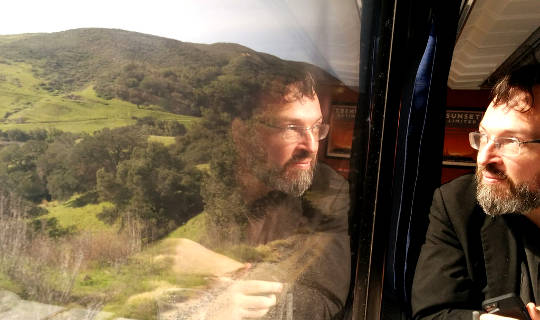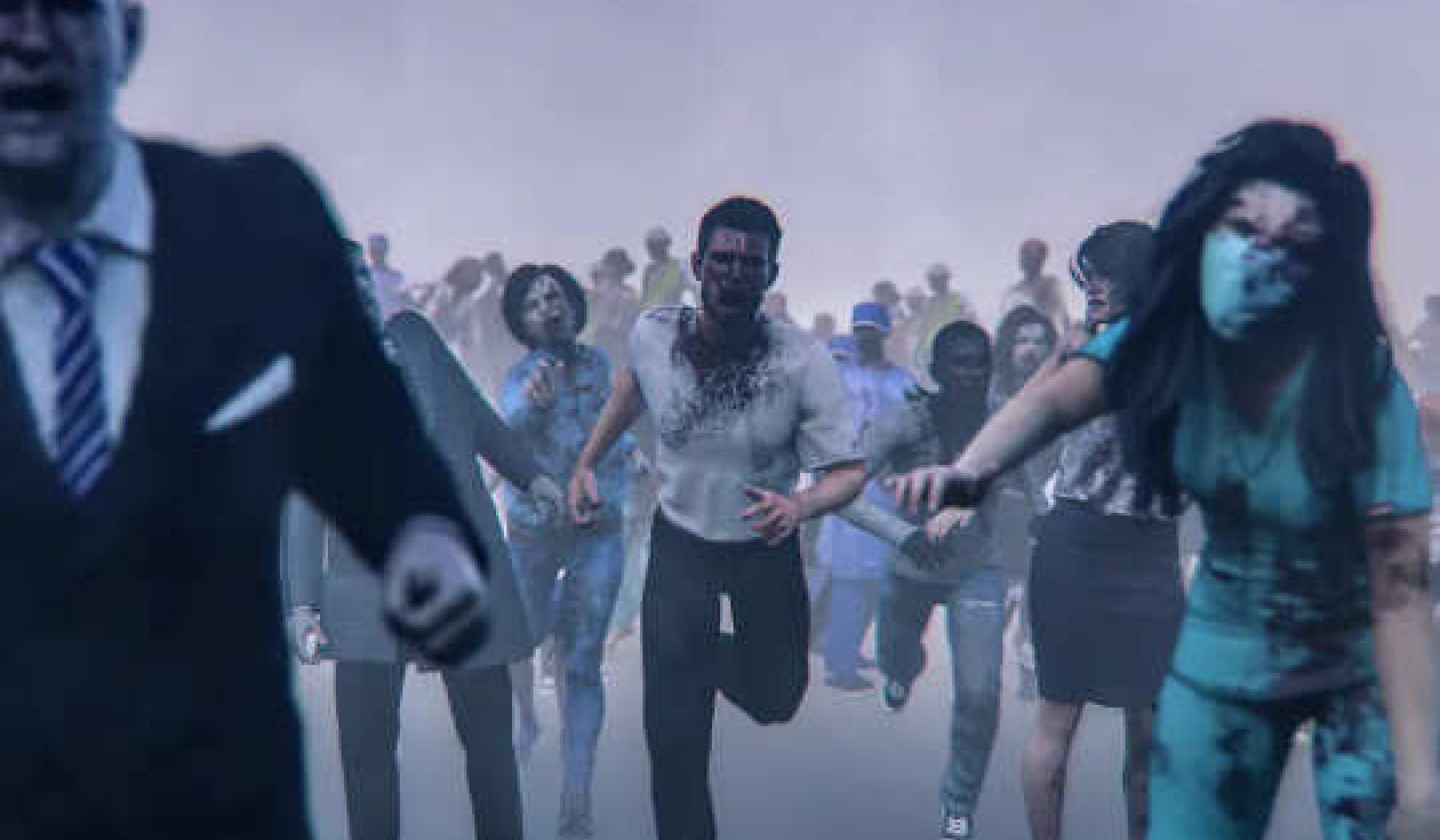
Photo credit: Liz Henry. (CC 2.0)
Sunrise touches the Utah mesas, lighting high orange cliffs above the gray chaparral. The train sways through the curves and switches. Rio Grande coal cars fill a long railroad siding, ending at the broken windows of the Desert Moon Hotel.
Jordan is dead, killed by men who wanted something. Either his possessions or simply the pleasure of inflicting pain. If they hoped to find power by creating suffering, they have succeeded. By putting a bullet in his back, they took our son, and so much of what made life mean anything to us.
As the early light works through the crevices and canyons, we are on our way to Chicago to meet a man who has found a way for the living and the dead to talk. His name is Allan Botkin, and he knows how to induce a state in which those who grieve can hear directly from the ones they have lost. I don’t fully believe, but it’s all I have.
Jude and I sit on the edge of our narrow bunk. We have pictures and mementos of Jordan’s life. The light is stronger now, the world outside the window no longer hidden in shadows. At this moment, our journey feels absurd. The clarity of light suggests the eternal separation of what can be seen from what cannot, of the physical and known from the hoped for and ephemeral.
Jordan’s ashes are in the closet of his room back in Berkeley. They weigh about the same as he did when I first carried him from the nursery to his mother. And now we are trying to find him, to reach past every empty place to hear his voice again.
In Chicago it is gray, with wind careening off the Great Lakes. Allan Botkin practices, weekends only, in the office building of some large corporation. We meet with him in a conference room situated within a rabbit warren of work cubicles. Botkin explains that the procedure he uses for induced after-death communication (IADC) was discovered by accident.
From PTSD to After-Death Communication
As a psychologist with the Veterans Administration (VA), he often treated post-traumatic stress disorder with core-focused EMDR, Botkin’s own variant of eye movement desensitization and reprocessing (EMDR), developed by Francine Shapiro. It’s a simple process that encourages patients to visualize a traumatic scene and then move their eyes back and forth. The eye movement serially stimulates opposite sides of the brain, inducing a gradual reduction of emotional pain.
A large body of scientific literature documents the effectiveness of EMDR; it works with about 75 percent of trauma patients. I am a psychologist. I have used EMDR myself, hundreds of times, primarily with people suffering the effects of early sexual abuse.
Botkin stumbled into his induced after-death communication protocol with Sam, a veteran who had never recovered from the death of Le, a young Vietnamese girl he had planned to adopt. Botkin guided Sam through numerous sets of eye movements as the man focused his attention on his sadness and on the memory of Le lying dead in his arms.
When Sam reported that the pain began to subside, Botkin did one more set of eye movements but with no specific instructions. Sam closed his eyes and fell silent. Then he began to cry. When Botkin prompted the man to describe his experience, he said, “I saw Le as a beautiful woman with long black hair. She was in a white gown surrounded by radiant light. She thanked me for taking care of her before she died....Le said, ‘I love you, Sam.’ ” [Allan Botkin, Induced After Death Communication]
Botkin realized he had witnessed what might be an after-death communication — made possible by a simple variant on the EMDR procedure. He set out to discover if Sam’s experience was replicable. Over the next several years, Botkin initiated the new procedure with eighty-three patients at the VA. All were suffering profound grief. None were told what to expect, other than a general description of EMDR and its effectiveness with trauma and grief. Eighty-one out of those eighty-three patients experienced an after-death communication — 98 percent.
Now It's My Turn
Once Jude and I are settled in the conference room, Botkin interviews us together. Later, we each come alone for the EMDR procedure. When it is my turn, I notice that Botkin’s face seems etched with some residual of the pain he’s witnessed. He moves slowly, as if his limbs carry an invisible weight. To guide the eye movement, he uses a wand made from a thin PVC pipe edged in blue tape. “It works,” he says, beginning a steady movement of the wand.
He asks me to imagine the scene in which I learned of Jordan’s death. It began with a call from the San Francisco medical examiner. “I have the worst news anyone can get,” the man said. “Your son was riding home on his bike late last night — around one thirty — and he was attacked on the street. He was shot. I’m sorry to say he died at the scene.”
And then I had to make my own phone calls. “We lost Jordan,” I would say after apologizing for having sad news. At the time, the meaning of the words had hardly sunk in, but as I sit with Botkin they burn like acid, and I can barely stand to think of them.
During the EMDR, I focus on the sound of the words: “the worst news...we lost Jordan.” Over and over, my eyes follow the wand moving. I see Jordan slumping in the doorway where he died. Botkin continues until an odd numbness sets in, a lifting of the weight.
This is the way EMDR works. I have seen it so many times with my own patients — how they begin to let go of the pain, how the frozen images and feelings start to soften.
“Close your eyes,” Botkin finally intones. “Let whatever happens happen.”
Nothing. A distant panic starts — that I have come all this way for silence. That my beautiful boy is unreachable; I will never hear from him again. I wonder if the fact that I use EMDR in my own work, and know what to expect, is getting in the way.
I open my eyes. Then Botkin moves the wand once more and I follow it. Again he enjoins me to close my eyes, to let go to whatever happens.
And now, quite suddenly, I hear a voice. Jordan is speaking, as if he were in the room. He says:
Dad...Dad...Dad...Dad. Tell Mom I’m here. Don’t cry...it’s okay, it’s okay. Mom, I’m all right, I’m here with you. Tell her I’m okay, fine. I love you guys.
Those are the exact words. And they convey the two things I most needed to know: that Jordan still exists and that he is happy. The pain of his last moments is long over, and he is in a place that feels good.
The next day we leave Chicago. Jude, despite all our hope, hasn’t heard Jordan’s voice. For her, the silence of the dead remains. All I can give her are words that only I heard. But I feel a sense of reconnection. What had been severed is again whole; what had been lost has been given back to me. I heard my boy. I learned that on different sides of the curtain of death we still have each other.
On the train home I feel lighter. But as we cross the gray waters of the Mississippi, I have a familiar thought: that Jordan can’t see this, that all I experience — and all I feel — is unknowable to him. I touch the window as if reaching for something. Then I remember his words: “I’m here with you.” Moments later, light fades on the old brick facades of Burlington. I imagine showing it to Jordan.
And Then What?
When we came home, Jude and I resolved to listen and look for Jordan in any way we could. I wrote in my journal:
The left hand doesn’t know the right hand. The conscious mind doesn’t remember what the unconscious holds. All around, the voices of the dead are speaking. But we are afraid because it’s considered madness to listen.
On the right side of the brain we can listen — because that’s where we intuit; that’s where we know wisdom. On the left side, we make up the story of being alone. Invisible.
Our hands join in prayer. But the prayer is speaking without listening. The mind finds words for love. Describing it. Seeking the beauty of being known, accepted. But we remain deaf to the chorus that bathes us. Holds us. Takes each step with us.
Copyright ©2016 by Matthew McKay, PhD.
Reprinted with permission from New World Library.
www.newworldlibrary.com
Article Source
 Seeking Jordan: How I Learned the Truth about Death and the Invisible Universe
Seeking Jordan: How I Learned the Truth about Death and the Invisible Universe
by Matthew McKay, PhD.
Click here for more info and/or to order this book.
About the Author
 Matthew McKay, PhD, is the author of Seeking Jordan and numerous other books. He is a clinical psychologist, professor at the Wright Institute in Berkeley, CA, and founder and publisher at New Harbinger Publications. Visit him online at http://www.SeekingJordan.com.
Matthew McKay, PhD, is the author of Seeking Jordan and numerous other books. He is a clinical psychologist, professor at the Wright Institute in Berkeley, CA, and founder and publisher at New Harbinger Publications. Visit him online at http://www.SeekingJordan.com.































